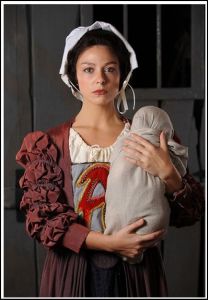 As I began to read The Scarlet Letter, the first thing that caught my attention was the characterization of Hester Prynne. Hester, who I assume is the protagonist of the story based on the fact that she wears the scarlet letter, is first introduced in the novel as the crosses the threshold of the town prison. It is what she does after being drawn across the threshold that first caught my attention.
As I began to read The Scarlet Letter, the first thing that caught my attention was the characterization of Hester Prynne. Hester, who I assume is the protagonist of the story based on the fact that she wears the scarlet letter, is first introduced in the novel as the crosses the threshold of the town prison. It is what she does after being drawn across the threshold that first caught my attention.
After the “town-beadle” pulls Hester across the threshold, she “repels” him (50). This simple act of pushing his hand aside speaks volumes about Hester without directly stating anything about her character. Due to our background knowledge, we know that Hester is living in Puritanical Salem. Women in any puritan society had fewer rights than men. Hester’s act of repulsion is an act of defiance. She pushes away the her captor’s hands and emerges into the open air “as if by her own free will” (50). I find it interesting that Nathaniel Hawthorne chose this act as the first device by which he would describe Hester. Despite his rich and descriptive language, which he is all too happy to use while describing the character that adorns her blouse, he uses one simplistic act to describe Hester. She pushes away the hand of a man and walks out of the prison, refusing to be guided–Hawthorne describes this as a force of character. This is the first example of indirect characterization of Hester in the novel; and it suggests to me that Hester is a strong and independent young woman.
Farther down page 50, Hawthorne directly characterizes her. “The young woman was tall, with a figure of perfect elegance on a large scale. She had dark and abundant hair, so glossy that it threw off the sunshine with a gleam, and a face which, besides being beautiful from regularity of feature and richness of complexion, had the impressiveness belonging to a marked brow and deep black eyes” (50). In these two complex sentences, the author paints a rather vivid picture of our assumed heroine. She is a beautiful specimen in a town full of “not unsubstantial persons” (47). I believe that Hawthorne has made Hester beautiful to make a commentary on the nature of sin itself. Even though Hester has committed the crime of adultery, she is still more outwardly, and inwardly, beautiful. This is in direct contrast to the “righteous” woman of the town who fully abide by the laws, and yet they are described as rather ugly. Hawthorne is trying to show that Hester is still a beautiful person, despite her adultery. And maybe, Hawthorne is providing a commentary on the rigidity of the Puritan community and how unaccepting they are of a sinner like themselves.
As the exposition of the book begins, so does Hester’s characterization. Hawthorne gives quite a lot of information about her in the first four chapters, and yet it is not quite enough. The rest of the book will assuredly fill in the gaps; we do not know her full character yet. Hawthorne laid the skeleton in these first few chapters, and he’ll flesh it out as the book continues.
Works Cited
Hawthorne, Nathaniel. The Scarlet Letter. New York: Bantam, 1986. Print. Reissue 2003.
Hester does definitely seem to differ from the rest of the women in society. She hasn’t just committed a horrible crime, but she is also regarded by Hawthorne as beautiful, whereas the other women seem to be ugly, even though they have not committed any such crime. I really like how you presented this idea in your post.
LikeLike